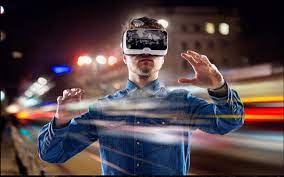Augmented reality and virtual reality: the next frontier in immersive experiences

Augmented reality (AR) and virtual reality (VR) are two technologies that have the potential to revolutionize the way we experience and interact with the world around us. Both of these technologies offer immersive experiences that allow users to feel as though they are part of a different reality.
AR involves overlaying digital information onto the physical world. This can be achieved using a variety of devices such as smartphones, tablets, or AR glasses. By using AR, users can interact with digital objects that appear to be part of the real world. For example, an AR app might allow users to see virtual furniture placed in their actual living room, or provide information about a product simply by pointing their smartphone at it.
VR, on the other hand, involves creating a completely artificial environment that users can interact with through a headset or other device. With VR, users can feel as though they are physically present in a different world. This can be used for a variety of applications, such as gaming, training, or even therapy.
Both AR and VR are rapidly advancing and becoming more accessible to consumers. As these technologies continue to evolve, we can expect to see them used in increasingly innovative ways, from education and entertainment to healthcare and beyond. The possibilities for immersive experiences are endless, and AR and VR are poised to be at the forefront of this exciting new frontier.
One area where AR and VR are already having a significant impact is in the world of entertainment. With AR, users can attend concerts, festivals, and other events from the comfort of their own home, while still feeling as though they are part of the crowd. VR, on the other hand, allows users to enter fully immersive gaming worlds, where they can interact with characters and objects in ways that were previously impossible.
Another area where AR and VR are being used is in education and training. With these technologies, students can explore historical sites, science labs, and other places that might be difficult or impossible to access in real life. VR can also be used to simulate dangerous or difficult situations, such as military training or medical procedures, allowing trainees to gain valuable experience without putting themselves or others at risk.
In healthcare, AR and VR are being used to improve patient outcomes and reduce costs. For example, AR can be used to provide surgeons with real-time information during procedures, while VR can be used to distract patients during painful or uncomfortable treatments.
Overall, the potential applications for AR and VR are vast, and as these technologies continue to evolve, we can expect to see them used in increasingly innovative and beneficial ways. From entertainment and education to healthcare and beyond, AR and VR are poised to be at the forefront of the next frontier in immersive experiences.



